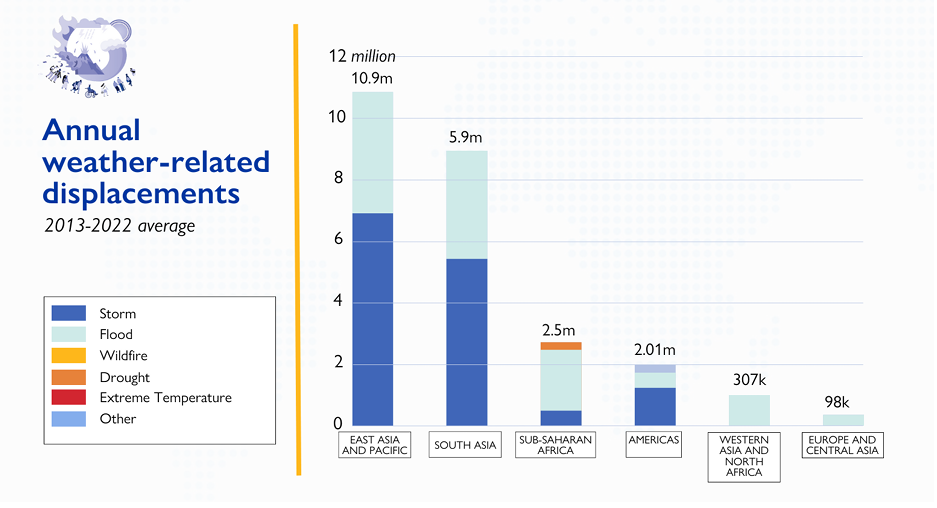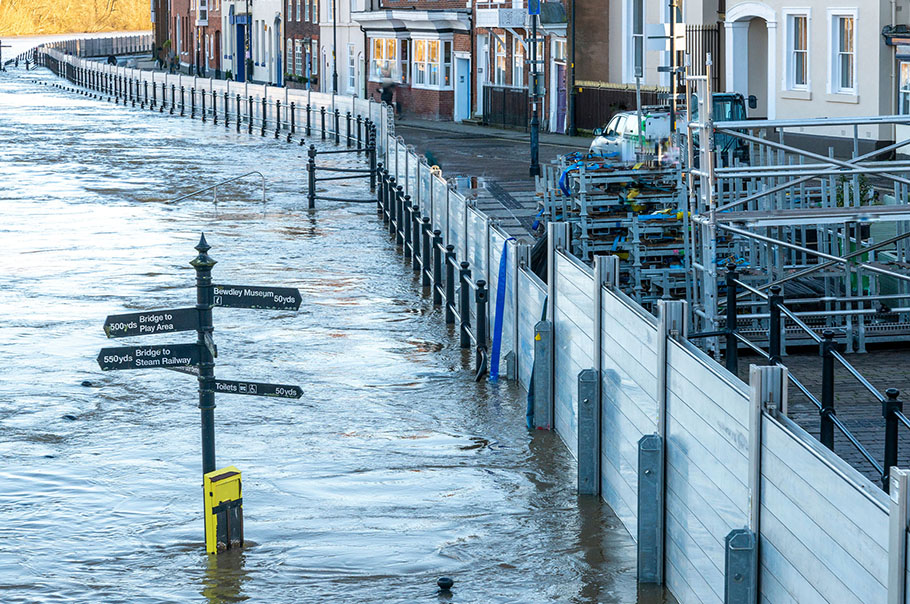Climate change is fundamentally altering the landscape of the United States and around the globe, leading to shifts in population patterns in the future. Many scientific projections indicate that climate change could displace hundreds of millions of people in the coming decades due to rising seas, extreme weather events, drought, and other environmental impacts.
Climate and extreme weather risks, along with their financial impacts, are starting to play a small role in influencing where people decide to live. Some of that is due to increasing insurance as a result of extreme weather events such as wildfires, high winds and flooding. However, there are several factors that seem to be contributing to these population shifts.
The magnitude of worldwide displacements triggered by weather-related events today illustrates the importance of developing a better understanding of the relationship between climate hazards and human mobility. New internal displacements due to storms, floods, wildfires, droughts, and extreme temperatures have been estimated at 21.9 million annually across the past decade (31.8 million in 2022).

Coastal Migration and Rising Seas
Coastal areas are witnessing significant population shifts due to rising sea levels and the increasing frequency of extreme weather events. Cities like Miami, New Orleans, and New York City are experiencing gradual population declines as residents seek safer inland areas, according to NOAA.
This trend is not only driven by the direct threat of sea-level rise but also by the compounding impacts of storm surges, erosion, and saltwater intrusion into freshwater sources. Communities are faced with the complex decision of whether to fortify existing infrastructure or to consider managed retreat.
Low-lying coastal areas are at particular risk. A Climate Central study estimates that average global sea level rise could flood lands currently home to 187 million people by 2050 with islands such as Fiji, the Maldives, and Tuvalu may become entirely uninhabitable. You also can view their Climate Vulnerability map.
Displacement Due to Natural Disasters
The Migration Policy Institute has found that climate-related disasters, such as hurricanes, wildfires, and floods, are prompting internal displacement of populations within the U.S. This is not confined to any specific region; it affects both urban and rural areas.
Communities in disaster-prone regions are experiencing the compounding effects of repeated disasters, leading to prolonged displacement and potential long-term demographic shifts. These events strain local resources and necessitate comprehensive strategies for resilience and recovery.
Around 1.4 billion people worldwide could be displaced within their own countries by 2060 due to climate change impacts based on modeling studies. The scale of internal and cross-border migration is expected to increase substantially compared to current levels.
Urbanization and Vulnerability
Urban areas are facing unique challenges related to climate change, including heat islands, inadequate infrastructure, and increased health risks. Residents in densely populated cities are confronted with higher exposure to extreme heat events and a lack of green spaces.
Consequently, The Urban Climate Change Research Network (at Columbia) found that some urban residents are considering more climate-resilient communities in suburban or rural areas. This trend highlights the importance of urban planning, green infrastructure, and sustainable transportation solutions to create livable, climate-resilient cities. The UCCRN is currently working on a revised study to assess the urban climate risk frameworks and climate science for cities and derives policy implications for key urban sectors, with an estimated release in 2024.
The U.S. Climate Vulnerability Index has been published, in tandem with Texas A&M, the Environmental Defense Fund and Darkhorse Analytics, an interactive map that visualizes how to understand drivers of vulnerability communities and allows you to see how communities compare on risks across the U.S. The map shows the severity of the selected indicator across the U.S. Darker colors represent higher vulnerability.
Economic Impacts on Communities
Communities dependent on climate-sensitive industries like agriculture, fisheries, and tourism are facing economic challenges. Prolonged droughts, changing precipitation patterns, and increased frequency of extreme weather events directly impact livelihoods.
This economic strain leads to involuntary population shifts as residents seek economic stability in more resilient regions. Addressing these challenges requires a holistic approach, including diversification of local economies and targeted support for impacted communities. Rural farmers and communities may face a profoundly difficult transition if forced to abandon homes and relocate.
Inland regions will also face threats that make habitation and agriculture difficult. For instance, Sub-Saharan Africa is projected to experience dangerous heat levels and drought conditions that could render large areas unsuitable for human survival. Drought risk is also increasing substantially across Central America, the Middle East, and South Asia.
Navigating the Future
Recent years have seen substantial progress on projecting human exposure to climatic hazards – including heat waves, droughts, wildfires, floods, storms, sea level rise, and crop failure – across different parts of the world and for different global warming scenarios. Addressing climate-driven population shifts requires strategic planning and community preparedness. This involves implementing climate adaptation strategies, investing in resilient infrastructure, and developing equitable policies to support affected populations.
Climate-induced population shifts are an objective reality, reshaping the places we call home and influencing how and where we choose to live. Understanding these trends is vital for building a more resilient and sustainable future.
To help businesses navigate climate change and climate risk, Weather Source formed a Climate Risk Enterprise Solutions Group that has developed extreme weather climatology products which provide a foundation for understanding and quantifying the probability of various weather phenomena under our planet’s current climate conditions and act as (i) a reference for current climate means and variance for any location; (ii) current climate trends for any location; (iii) support scenario planning with respect to currently climate trends; and more. In addition to our OnPoint Product Suite which delivers a wealth of accurate and actionable global weather data down to hyper-local points of interest, our climate risk intelligence products will provide critical climate risk intelligence to help businesses and organizations navigate evolving climate risks and opportunities going forward years and decades into the future.



